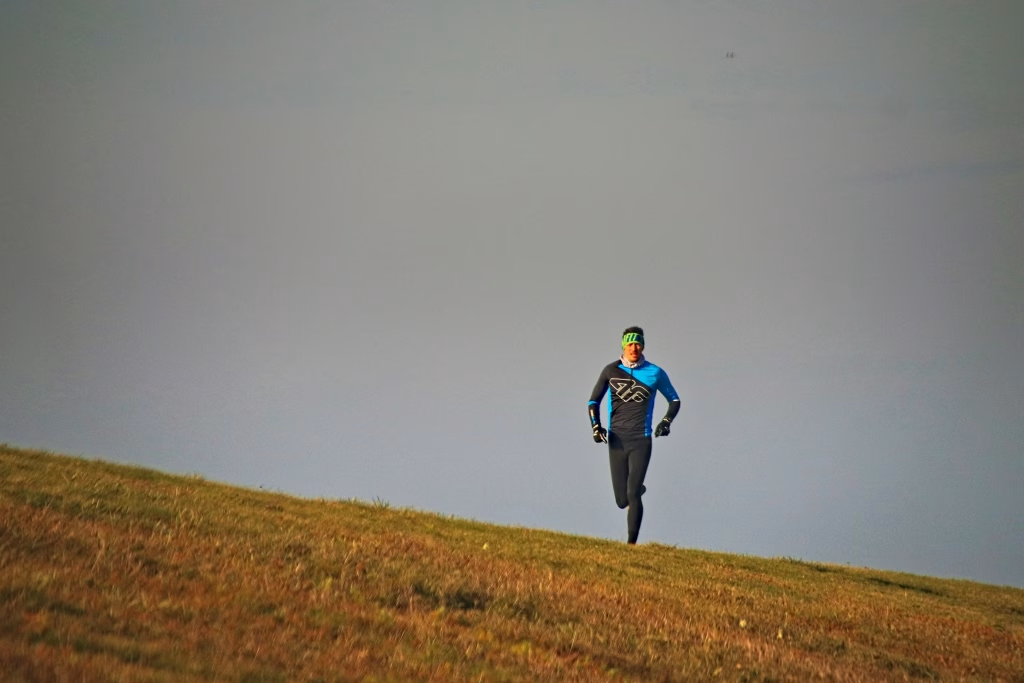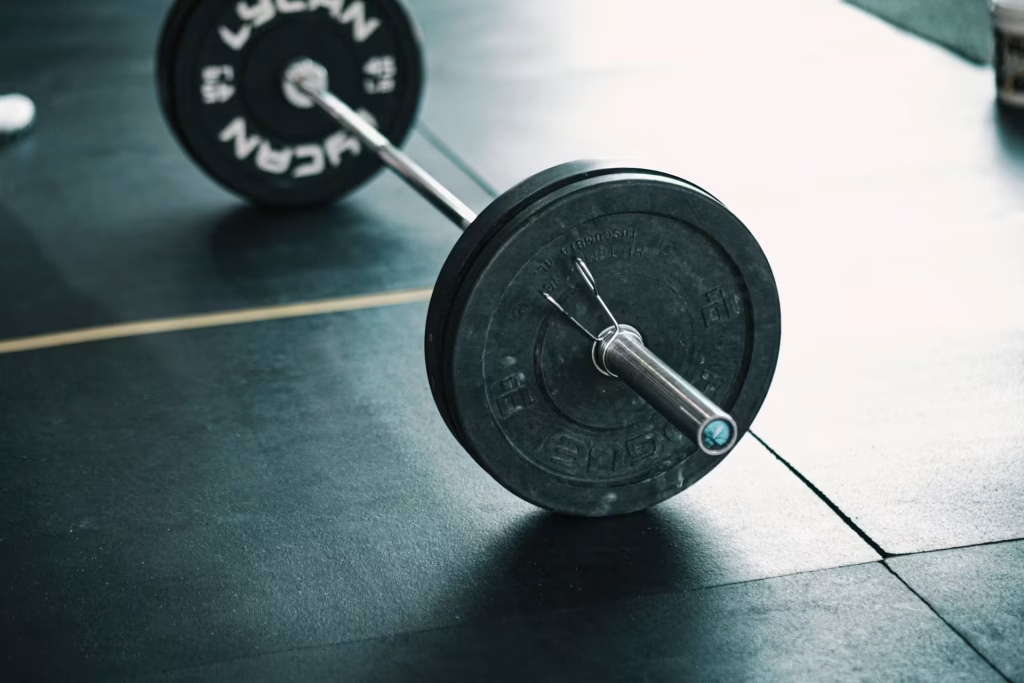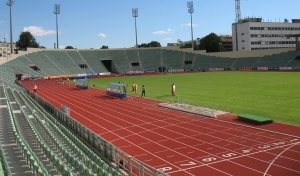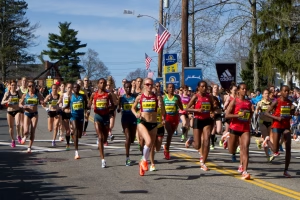Why is running economy important?
Running economy refers to the oxygen cost of running per kilometer.
It is expressed relative to your body weight so it can be compared to people of different sizes. All other things being equal, the athlete with the best running economy will win. This would mean that less oxygen is used at a given speed. Or, the athlete will run faster at the same level of oxygen use.
The performance model
It’s important to understand how running economy fits with our running performance model. You have been training to increase your VO2 max. You have been training to increase your anaerobic threshold. What else? One more thing – running economy. It’s the third piece of our distance running performance model. Let’s review.
First, you want to have a high VO2 max (click here to learn more). VO2 max represents your maximum aerobic capacity. For the long distances (5000 m and up), all aerobic function must happen below this maximum value, so it makes sense to widen the range of your physiological capabilities.
Second, you want to have an anaerobic (lactate) threshold as high as possible (click here to see how). The anaerobic threshold is often reported as the percentage of VO2 max at which it occurs. This is also key to optimal distance running performance, especially for the longer distances.
Remember that for two athletes of identical VO2 max, the one that has the higher anaerobic threshold will win.
Running economy, on the other hand, represents the energy cost of exercise. If you can minimize that (improve your economy), you make everything easier for the physiological system that must deal with that cost. It’s the third component, and it’s not to be neglected!
What factors determine running economy?
There are many factors that determine how much oxygen you use when you run. Some of these are more modifiable than others. We can likely say that no individual athlete is going to be the best in all of these factors at once, although world class runners likely are close to optimal in most of these factors.
The good news is that this list of factors have lots of training potential for runners of all levels.
Body size
Because running requires you to move your own body weight, it helps to have a low percentage of body fat. Remember that this only works as long as you have a healthy body fat level, and it is not a good idea to focus on this before other training practices that enhance running economy.
Body shape
It can help to have a leg morphology that has the bulk of the mass closer to the hip. This makes it easier to swing the leg.
Think of the legs of deer and antelope, which have effective muscle closer to the pelvis, and very thin legs closer to the hooves. This is probably not something you can change, but certain ethnic groups, such as those from north and east Africa (like Ethiopia and Kenya) have this profile, which may explain some of their distance running success.
Muscle fiber composition
Having a higher percentage of slow twitch muscle fibers may be related to enhanced running economy (Saunders et al. 2004).
But this may not be something you can change too much, as it depends largely on your genetics. What you can do, however, is train in such a way that your slow twitch muscle fibers receive maximum benefits.
Mobility
If running economy is the goal, a discussion about mobility and flexibility is really a discussion about joint stiffness. In this context, stiffness doesn’t mean the painful inability to move your joint, but rather having a robust elasticity and spring during the running stride. An optimally stiff joint allows energy return to happen, yet still has the appropriate mobility to move well.
You want to have mobility where it matters, to allow the appropriate forward and back movement of the legs as you land and push off. A body part that isn’t as mobile as it should be will cause you to run with faulty movement that can lead to an overuse injury.
But where this isn’t the case, it can help to have an appropriate level of stiffness, especially in the ankle-foot complex, which is the structure that bears most of the shock as you contact the ground and push off with every stride.
Optimal stiffness in certain body parts can also help minimize the side-to-side movement in your core, hips, and knees because side-to-side movement doesn’t contribute to the forward progression of running.
This stiffness leads to appropriate stability in these areas, which enhances your resilience against injury.

Running technique
Many people want to know if there is an optimal running technique that enhances running economy. The answer is probably yes, but what makes this so difficult is that you can’t just learn the technique, put it into action, and immediately reap the benefits. That would be a backward approach.
What you want to do instead is train your physical abilities so that the elements of running technique below are just the natural way you would run without thought.
According to a review by Anderson (1996), there are many aspects of running technique that seem to be related to good running economy.
First, he suggests that runners with excellent economy arrive at their own optimal stride length by accumulating lots of training over the years. I take this to include all the beneficial parts of training – relatively high mileage, strength and conditioning, but also the learning that accompanies all of that as you learn how best to move your own body to perform at your best.
Second, runners with great economy have a low vertical oscillation. This means that they don’t have excessive up-and-down bouncing of their center of mass each stride.
Have someone take a video of yourself running. If it looks like you have too much vertical movement, lean slightly forward and focus on pushing your feet behind you when you push off, rather than down into the ground.
Third, economical runners have a more bent knee during the swing phase of the stride. This is perhaps the best example of something that you can’t just decide to change – it needs to come naturally and without extra effort!
Fourth, superior economy can come from an appropriately stiff ankle and foot during toe-off. The foot doesn’t need to point down too much, (like a ballerina would), but it should move rapidly. This also means that the foot and ankle need to be sufficiently strong to not collapse during the toe-off, since power application of force at that time translates into forward speed.
Fifth, economical runners have a smaller amplitude of arm swing. The arms are only used to counteract the rotation of the lower body. Bending the arm more at the elbows sometimes helps.
Sixth, it’s beneficial to have a low peak ground reaction force. When you slap your foot on the ground and there’s a big shockwave that goes up your leg, that’s a high ground reaction force. Minimizing that by landing softly reduces the work that your muscles must do to counteract that impact.
Seventh, highly economical runners are able to use stored elastic energy. Again, the prime area in which this occurs is the ankle-foot complex, specifically the achilles tendon.
The achilles stretches and then shortens rapidly during each running stride. The better it is able to do this and return more energy into the running movement, the less oxygen is needed for a given speed. You can train this quality with plyometrics (see below).
Running shoes
Australian researchers have shown that lightweight shoes can help you run while using less oxygen. The heavier the shoe, the greater the metabolic cost of running (Fuller et al. 2017).
They state further that if both of your shoes together have a mass less than 440g (15.5 oz) there would be no detrimental effect on running economy, even if you increase the weight within that range. This corresponds with 220 g (7.75 oz) per single shoe, which is on the lighter side of what is available in the market.
The above benefits need to be understood in the context of injury risk. If your shoes are very light but don’t allow your foot to move well or otherwise lead to chronic injury, the benefit is not worth it.
A better plan would be to use your lightest shoes (i.e., racing flats or spikes) for races in which you can tolerate potentially less support for the entire race.
Environment
Hot temperatures leading to significant thermal stress and a higher core temperature can impair running economy (Saunders et al., 2004). This is somewhat controllable in the sense that you may be able to choose where and when to train. However, in hot-weather races, running economy (among other things) are impacted negatively, so expectations should be modified.
Fortunately, it is likely that heat adaptation through careful exposure to thermally-stressful training can probably mitigate some of this.
How do you test running economy?
A running economy test requires the same laboratory device as a VO2 max test. So, unfortunately, it’s not something that is immediately accessible to everyone. Such tests tend to be available at university exercise physiology laboratories or a hospital or medical system that has a sports performance program.
The test will be run on a treadmill, and you will need to wear a breathing mask or mouthpiece. The machine measures the oxygen that goes in and comes out. The difference between the two is how much oxygen you used for each running speed.
The test will generally include a few key running speeds below your VO2 max. For example, a protocol used by the Australian Institute of Sport (Saunders et al., 2004) had athletes running at 14, 16, and 18 km/h. Each speed is done for 4 minutes, with a 1 minute rest in between speeds.
In each stage, the oxygen consumption doesn’t increase right away, but by the 4th minute, it tends to reach a steady state. That value is then used to report running economy for that stage. You will likely also have heart rate data given to you as part of the report.
How can you improve your running economy?
There are several training interventions that can help improve running economy. It’s not surprising that the greatest improvements will come to those individuals who have not yet included these things in their training program, but many benefits continue to increase long term.
The good news is that most people will find something below that they can try for the first time. Let’s discuss these suggestions in order of increasing level, from basic to advanced.
Training element 1: Mobility
Level: basic
It’s important to have mobility where it matters so you can move with good alignment and effective application of force.
You need to have good mobility in the parts of your body most concerned with posture during running, such as your pelvis, torso, and shoulders. Any excessive tightness is going to cause your postural alignment to suffer. As a consequence, muscles on the other side of your body will need to work extra hard to pull you back into position.
Example: if your hip flexors are tight, your pelvis will tilt forward too much. This stresses your core muscles and takes your legs out of alignment during the running stride so they can’t land and propel effectively.
Training element 2: Drills
Level: basic
Drills provide the opportunity to refine movement skill using the mobility you have developed.
Because drills are generally not against any resistance (i.e., no weights attached), they are relatively low intensity. However, if you are new to drills, there is still the potential for soreness after a first try.
Drills focus on important parts of your running technique. They primarily include movements emphasizing the hip, knee, and ankle. You will not only focus on the range of motion, but also ensure that the movement is performed at the right speed.
The drill should duplicate (or slightly exaggerate) the range of motion and speed of movement used during actual running.
Example: running high knees (hip flexion emphasis), butt kicks (knee flexion emphasis), quick running ankles (ankle/foot speed emphasis). A duration of 10-30 sec allows you to challenge yourself without technique breakdown due to fatigue.
Training element 3: Uphill running
Level: basic
Below you will learn specific strength training exercises to enhance running economy. Uphill running can be viewed as a running-specific form of resistance training (Barnes & Kilding, 2015). Because it requires no special equipment, uphill running can be especially useful for those without access to specialized strength training equipment.
Example: Canova hill repeats, used by marathon coach Renato Canova. Over several weeks, work up to 10 * 100 m hill repeats with a jog back to the beginning. Remember to warm up well beforehand, or perform after an easy run. An incline of about 6% would be appropriate.

Training element 4: Speed endurance training
Level: basic
Speed endurance is the ability to maintain your maximum or near maximum speed in the longer sprints.
Researchers from the University of Copenhagen (Vorup et al., 2016) used speed endurance training to improve running economy.
The 8 week program consisted of 4 to 8 reps of 30 seconds running at 90-95% maximum speed with 3 minutes passive recovery.
This training was also combined with strength movements such as squat, leg press, and deadlift. The athletes started at 1*10 reps to failure, and progressed the training by doing more sets at fewer reps to failure. In the last week, they performed 4 sets of 4 reps to failure, with 3 minutes rest in between sets.
Training element 5: Heavy Strength training
Level: intermediate
This is the sort of training in which you are lifting heavy weights for a low number of reps, likely at a relatively slow speed of movement. Often, the improvement in running economy happens without any increase to VO2 max (Johnston et al., 1997).
Even a simple strength training program can lead to improvements in running economy. For example, Norwegian researchers (Støren et al., 2008) had runners with no recent strength training experience and performances of about 18-19 minutes in the 5k.
The runners added an 8 week strength training program to their regular training. The strength training consisted of 4*4 reps of half squats with 3 minutes of rest between 3 days per week. The weight was so heavy they could only do 4 reps at a time. When they could do 5 reps, 2.5 kg was added to the next set.
Improvement: 5% enhancement in running economy.
French sport scientists had triathletes do 14 weeks of heavy weight training, which led to an 10-11% decrease in the amount of oxygen used at submaximal running speeds.
This strength training targeted the quadriceps, hamstring, and calf muscles. Workouts consisted of 3-5 sets of 3-5 reps to failure (Millet et al., 2002).

Training element 6: Explosive strength training
Level: advanced
Explosive strength training involves lifting very light weights at a high to maximum speed.
Sport science research from Finland (Paavolainen et al., 1999) had endurance athletes replace some of the time they spent doing endurance training, while keeping the total training time the same.
Athletes who replaced 32% of their training time with explosive strength training improved their 5k time and running economy compared to those athletes who only replaced 3% of their training time with explosive strength training.
The explosive-strength training consisted of sprints of 20 – 100m, jumping, leg-press, and knee extension with low loads (0-40% of 1 rep max) and fast movement speeds. From this training you can expect improved joint stiffness and beneficial neural adaptations without any growth in muscle mass.
Training element 7: Plyometrics
Level: advanced
Plyometric training involves rapid jumping and other movements that train the stretch-shortening cycle. The stretch-shortening cycle is what happens when you contact the ground with each running stride. Your tendons and muscles rapidly stretch as they absorb and cushion the shock from the landing and then shorten as they then propel you forward and up again.
Australian sports science researchers (Spurrs et al 2003) used 6 weeks of plyometric training to bring about improvements in muscle-tendon stiffness, rate of force development, and running economy, with no change in VO2 max or lactate threshold.
The program was done with the following exercises. The total foot contacts during each session were gradually increased from 60 to 180 over the six weeks.
Exercises (2-3 sets of 6-15 reps, subject to foot contact limit):
- Squat jump
- Split scissor jump
- Double leg bound
- Alternative leg bound
- Single leg forward hop
- Depth jump
- Double leg hurdle jump
- Single leg hurdle hop
Improvements:
- 3 km performance: increased by 2.7%
- running economy: increased by 4.1 – 6.7% at submaximal speeds
Overall strength training recommendations
A review article from Spanish and Greek researchers (Balsalobre-Fernández et al., 2016) recommends low to high intensity resistance and plyometric training 2-3 times per week for 8-12 weeks to improve running economy in highly trained middle and long-distance runners.
Denadai et al. 2017 concluded that explosive and heavy weight training enhanced running economy in the range of 3.6 – 4.85%. They also suggested that longer the training (i.e., months or years) would increase the percent change for the better.
Bonus 1: Altitude exposure
There is also the suggestion that altitude training, whether real or simulated, can enhance running economy through beneficial physiological changes. For example, Intermittent hypoxic exposure has been shown to improve running economy in well-trained runners.
Japanese researchers (Katayama et al., 2003) simulated an altitude of 4500 m (about 14,800 feet). This is a bit higher than Pikes Peak and a bit lower than Mont Blanc on the French-Italian border. Athletes spent 3 hours per day for 14 days to elicit physiological changes.
Improvements:
- Running economy improved by 2.6 – 3.3% at different speeds
- 3000 m time improved by 1%
Bonus 2: Heat training
Finally, training in warm to hot weather conditions can be beneficial for running economy. When you adapt to thermally stressful environments over several weeks, the associated lowered heart rate and core temperature may lead to an improved running economy (Thomas et al., 1995).
Summary
Along with VO2 max and anaerobic threshold, running economy is an important component of distance running fitness. Lowering your oxygen requirement at a given speed means that you are running at a lower percentage of your physiological capacity and can run faster at the same percentage of capacity.
Changes in running technique may lead to improved running economy, but these should be achieved naturally through other training such as mobility, hills, strength training, speed endurance, explosive-strength, and plyometric training.
Overall, running economy will be optimized by including these in a well-balanced comprehensive program over the long term. This may also include specialized environmental considerations such as heat and altitude training.
For the same aerobic fitness, the athlete with the better running economy will win, so a training program should include interventions with this in mind. Please tell us your experiences with these training approaches in the comments below!




